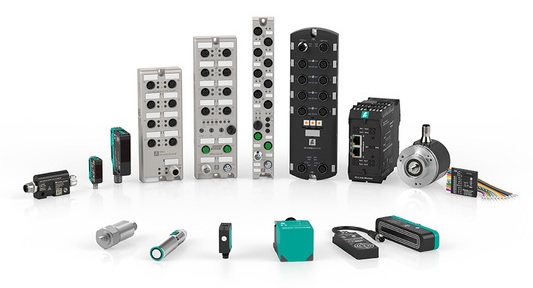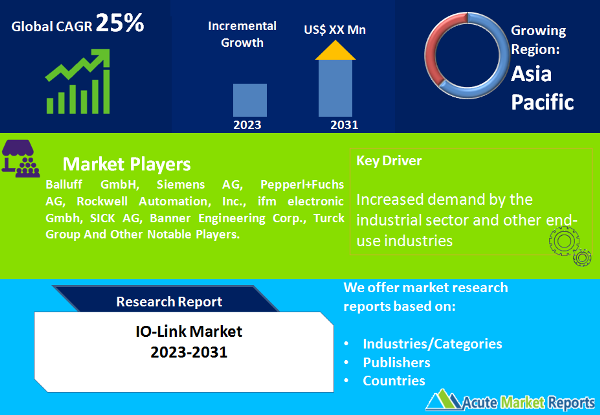
The IO-Link market has experienced significant growth in recent years and is expected to grow at a strong CAGR of 25% during the forecast period of 2025 to 2033, driven by the increasing adoption of industrial automation and the need for efficient and intelligent communication between devices in industrial settings. IO-Link is a standardized communication protocol that enables seamless connectivity between sensors, actuators, and other industrial devices, enhancing productivity, flexibility, and diagnostics capabilities. The market revenue for IO-Link has been steadily rising, and it is expected to continue its growth trajectory in the coming years. The IO-Link market revenue is primarily driven by the growing demand for automation and digitalization in various industries, including manufacturing, automotive, food and beverages, and pharmaceuticals. The deployment of IO-Link technology allows for real-time data exchange, remote configuration, and monitoring of devices, leading to improved operational efficiency, reduced downtime, and enhanced productivity. The ability of IO-Link to enable smart factories and Industry 4.0 initiatives further fuels its adoption, as companies strive to optimize their manufacturing processes and gain a competitive edge. The IO-Link market is also supported by the increasing emphasis on predictive maintenance and condition monitoring in industrial environments. IO-Link devices provide valuable diagnostic information, such as temperature, pressure, and vibration data, enabling proactive maintenance and preventing equipment failures. The integration of IO-Link with advanced analytics and cloud-based platforms allows for predictive analytics and real-time monitoring of machine health, optimizing maintenance schedules and minimizing unplanned downtime.

Increasing Demand for Industrial Automation
The growing demand for industrial automation is a significant driver for the IO-Link market. Industries across various sectors are increasingly adopting automation to improve productivity, reduce costs, and enhance operational efficiency. IO-Link plays a crucial role in enabling seamless communication and interoperability between devices in automated systems. According to a report by the International Federation of Robotics (IFR), the global sales of industrial robots reached a record high in recent years, indicating the rapid growth of industrial automation. The integration of IO-Link technology with industrial robots enables efficient data exchange, remote device configuration, and real-time monitoring, facilitating smoother and more intelligent automation processes.
Need for Intelligent and Flexible Device Communication
The need for intelligent and flexible device communication is another driving factor for the IO-Link market. With the rise of Industry 4.0 and the implementation of smart manufacturing concepts, there is a growing demand for devices that can communicate seamlessly and provide valuable data for decision-making. The Industrial Internet of Things (IIoT) has gained significant traction in industrial settings, where IO-Link acts as a key enabler for collecting and exchanging data from sensors, actuators, and other devices. By integrating IO-Link devices into the IIoT infrastructure, industries can achieve improved visibility, real-time monitoring, and enhanced control over their processes.
Focus on Predictive Maintenance and Condition Monitoring
The increasing focus on predictive maintenance and condition monitoring in industries is driving the adoption of IO-Link. Companies are realizing the benefits of proactive maintenance in reducing downtime, optimizing maintenance schedules, and maximizing the lifespan of their equipment. IO-Link devices provide valuable diagnostic information and enable predictive maintenance strategies. Several case studies and success stories highlight the effectiveness of IO-Link in predictive maintenance. For example, by using IO-Link sensors to monitor machine health parameters such as temperature, pressure, and vibration, companies can detect early signs of potential failures, schedule maintenance activities in advance, and avoid costly unplanned downtime.
Compatibility Challenges and Transition Period
One of the restraints faced by the IO-Link market is the compatibility challenges and the transition period required for widespread adoption. As IO-Link technology gains momentum and companies seek to integrate it into their existing systems, compatibility issues may arise due to differences in communication protocols and device specifications. Upgrading or retrofitting existing devices to support IO-Link can involve additional costs and efforts. Furthermore, during the transition period, where both legacy systems and IO-Link-enabled devices coexist, interoperability and integration complexities can arise, requiring careful planning and coordination. Case studies and industry discussions highlight the challenges associated with integrating IO-Link into existing automation systems. In some cases, companies have faced difficulties in ensuring seamless communication between IO-Link devices and legacy equipment due to variations in protocols and software interfaces. The need for coordination among different stakeholders, including device manufacturers, system integrators, and end-users, during the transition phase, is crucial to overcome these compatibility challenges.
IO-Link Wired Segment Dominated the Market
The type segment of the IO-Link market consists of two main categories: IO-Link Wired and IO-Link Wireless. IO-Link Wired refers to the traditional wired communication protocol that utilizes physical cables to establish the connection between IO-Link devices and the controller. This type of segment has been dominant in the market in 2024 and has generated significant revenue due to its widespread adoption across industries. IO-Link Wired devices offer reliable and robust communication, making them suitable for applications that require high-speed data transfer and precise control. On the other hand, IO-Link Wireless is an emerging segment in the market that offers the advantage of wireless communication, eliminating the need for physical cables. IO-Link Wireless devices leverage wireless protocols such as Bluetooth Low Energy (BLE) or radio frequency (RF) to establish communication between the devices and the controller. This type of segment has been witnessing a higher growth rate, exhibiting the highest CAGR during the forecast period of 2025 to 2033 in the IO-Link market. IO-Link Wireless technology provides flexibility in device placement, simplifies installation, and reduces wiring complexities, making it particularly suitable for applications where mobility and flexibility are essential. While IO-Link Wired currently holds the highest revenue share in the market, IO-Link Wireless is expected to experience significant growth in the coming years. The increasing demand for flexible automation systems, the need for simplified connectivity in dynamic environments, and the rise of Industry 4.0 concepts are driving the adoption of IO-Link Wireless. As the technology continues to mature and standards are further established, IO-Link Wireless is expected to gain wider acceptance and contribute significantly to the overall revenue of the IO-Link market.
The Hybrid Industries Segment to Promise Significant Growth During the Forecast Period
The IO-Link market can be segmented based on the industry in which it is deployed. The industry segment consists of three main categories: Process Industries, Discrete Industries, and Hybrid Industries. Process Industries refer to industries that involve continuous production processes, such as oil and gas, chemical, pharmaceutical, and food and beverage. These industries require precise control and monitoring of various parameters, such as temperature, pressure, and flow. IO-Link technology finds extensive application in process industries, enabling seamless integration of sensors, actuators, and other devices for real-time data acquisition and process optimization. The process industries segment held a significant revenue share in 2024 in the IO-Link market due to the widespread adoption of IO-Link technology for process automation and control. While the process industries and discrete industries segments currently hold substantial revenue shares in the IO-Link market, the hybrid industries segment is expected to exhibit the highest CAGR. The integration of IO-Link technology in hybrid industries provides a comprehensive solution for diverse manufacturing processes, driving the demand for IO-Link devices.
APAC Emerging as Potential Investment Destination During the Forecast Period
North America has emerged as a significant market in 2024 for IO-Link technology, driven by the presence of advanced manufacturing industries and the increasing focus on automation and Industry 4.0 initiatives. The region has witnessed significant adoption of IO-Link in sectors such as automotive, aerospace, and electronics manufacturing. Additionally, the high concentration of key players and technological advancements in North America contribute to its substantial revenue share in the IO-Link market. Asia Pacific (APAC) is experiencing significant growth in the IO-Link market, driven by rapid industrialization and the expanding manufacturing sector in countries like China, Japan, and South Korea. The region's focus on achieving high productivity, improving operational efficiency, and adopting smart manufacturing technologies fuels the demand for IO-Link devices. APAC is expected to exhibit the highest CAGR during the forecast period of 2025 to 2033, in the IO-Link market due to the growing investments in automation and the increasing adoption of Industry 4.0 concepts.
Market Competition to Intensify During the Forecast Period
The IO-Link market is highly competitive, with several key players striving to capture a significant share of the market. These companies focus on innovative product development, strategic partnerships, and expanding their global presence to maintain a competitive edge. While it is important to note that specific strategies and market positions may vary among players, an overall outlook can be provided. Some of the top players in the IO-Link market include Balluff GmbH, Siemens AG, Pepperl+Fuchs AG, Rockwell Automation, Inc., ifm electronic Gmbh, SICK AG, Banner Engineering Corp., and Turck Group, among others. These companies are known for their strong product portfolios, extensive industry experience, and global reach. They invest heavily in research and development to introduce advanced IO-Link devices that cater to the evolving needs of end-users across different sectors.
One key trend observed in the IO-Link market is the focus on developing IO-Link devices that are compatible with various fieldbus systems, enabling seamless integration into existing industrial automation networks. This allows end-users to leverage the benefits of IO-Link technology while maintaining compatibility with their existing infrastructure. Companies are also investing in developing robust and secure IO-Link solutions to address concerns regarding data integrity and cybersecurity.
Historical & Forecast Period
This study report represents analysis of each segment from 2023 to 2033 considering 2024 as the base year. Compounded Annual Growth Rate (CAGR) for each of the respective segments estimated for the forecast period of 2025 to 2033.
The current report comprises of quantitative market estimations for each micro market for every geographical region and qualitative market analysis such as micro and macro environment analysis, market trends, competitive intelligence, segment analysis, porters five force model, top winning strategies, top investment markets, emerging trends and technological analysis, case studies, strategic conclusions and recommendations and other key market insights.
Research Methodology
The complete research study was conducted in three phases, namely: secondary research, primary research, and expert panel review. key data point that enables the estimation of IO-Link market are as follows:
Market forecast was performed through proprietary software that analyzes various qualitative and quantitative factors. Growth rate and CAGR were estimated through intensive secondary and primary research. Data triangulation across various data points provides accuracy across various analyzed market segments in the report. Application of both top down and bottom-up approach for validation of market estimation assures logical, methodical and mathematical consistency of the quantitative data.
| ATTRIBUTE | DETAILS |
|---|---|
| Research Period | 2023-2033 |
| Base Year | 2024 |
| Forecast Period | 2025-2033 |
| Historical Year | 2023 |
| Unit | USD Million |
| Segmentation | |
Type
| |
Component
| |
Industry
| |
Application
| |
|
Region Segment (2023-2033; US$ Million)
|
Key questions answered in this report